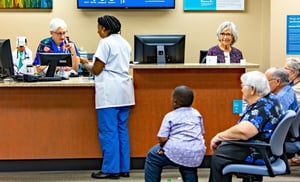
How Jane Pauley Community Health Center is Transforming Medicaid Enrollment
The Challenge
The Jane Pauley Community Health Center serves a rapidly growing patient population across 15 locations across Central Indiana with a modest staff of nine navigators. Like many FQHCs, they found themselves stretched thin by increasing operational demands.
- Limited Staff Resources
With only nine navigators responsible for all locations, the team was perpetually overextended, leaving some sites underserved and unable to respond to patients' enrollment needs efficiently. - Growing List of Responsibilities
Navigators were juggling multiple roles, from Medicaid enrollment to patient education and administrative tasks. These competing priorities left limited time to focus on ensuring comprehensive coverage for their patients. - Resource Constraints
Operating as a non-billable service department, expanding operations to meet growing demands wasn’t feasible without significant new funding or staffing, both of which were limited.
The mounting pressures not only affected patient care but also impacted financial potential, as lapses in patient coverage could result in significant revenue losses.
Solution Overview
After the conclusion of the COVID-19 emergency, many Medicaid patients transitioned from four years of not needing to redetermine their eligibility to having to complete periodic redeterminations. This shift created an urgent need to educate patients about the redetermination process and the steps required to apply for coverage to maintain their benefits. Recognizing this challenge, JPCHC’s senior leadership, including CFO Michael Dale, began searching for solutions specifically tailored to the unique needs of Federally Qualified Health Centers (FQHCs).
To address this need, JPCHC leveraged PointCare, a platform that supplemented the center’s in-person resources with virtual solutions. PointCare enabled patients to initiate or complete their Medicaid enrollment process outside of standard office hours, removing barriers caused by work or family commitments. By directing patients to use PointCare’s platform for virtual enrollment, JPCHC successfully managed increased patient volumes without incurring additional staffing costs.
The platform’s user-friendly, QR code-based process allowed patients to begin their enrollment applications independently, reducing wait times and minimizing unnecessary in-office visits. As Lindsay Cox, Enabling Services Manager at JPCHC, explained:
“[PointCare] is in addition to our navigators, who are still available. But if you have patients interested in applying for Medicaid, they can scan this QR code, and it will guide them through a virtual enrollment process. It’s the same application our navigators use. It’s nice to have an alternative to offer patients when a navigator isn’t available.”
Real-world Results
- Improved Coverage Continuity: Automated outreach has led to a significant reduction in Medicaid coverage lapses, ensuring consistent financial reimbursement for services provided.
- Enhanced Efficiency: Navigators could focus on higher-value tasks, making better use of their time and delivering quality service to patients who required in-person assistance.
- Greater Patient Accessibility: The after-hours enrollment option provided a lifeline for patients with unpredictable schedules, fostering trust and loyalty within the community.

"At first having PointCare come on, We were a little nervous because we thought…is this going to take our job away? What happened instead was that PointCare was that extra added support for those patients that we don't get to.We can't stay on top of contacting those patients all the time. So being able to have patients ran and just continuously checking for lapses and then the reach out to say, hey, your, your coverage is lapsed versus when they actually have an appointment and are in the office"
